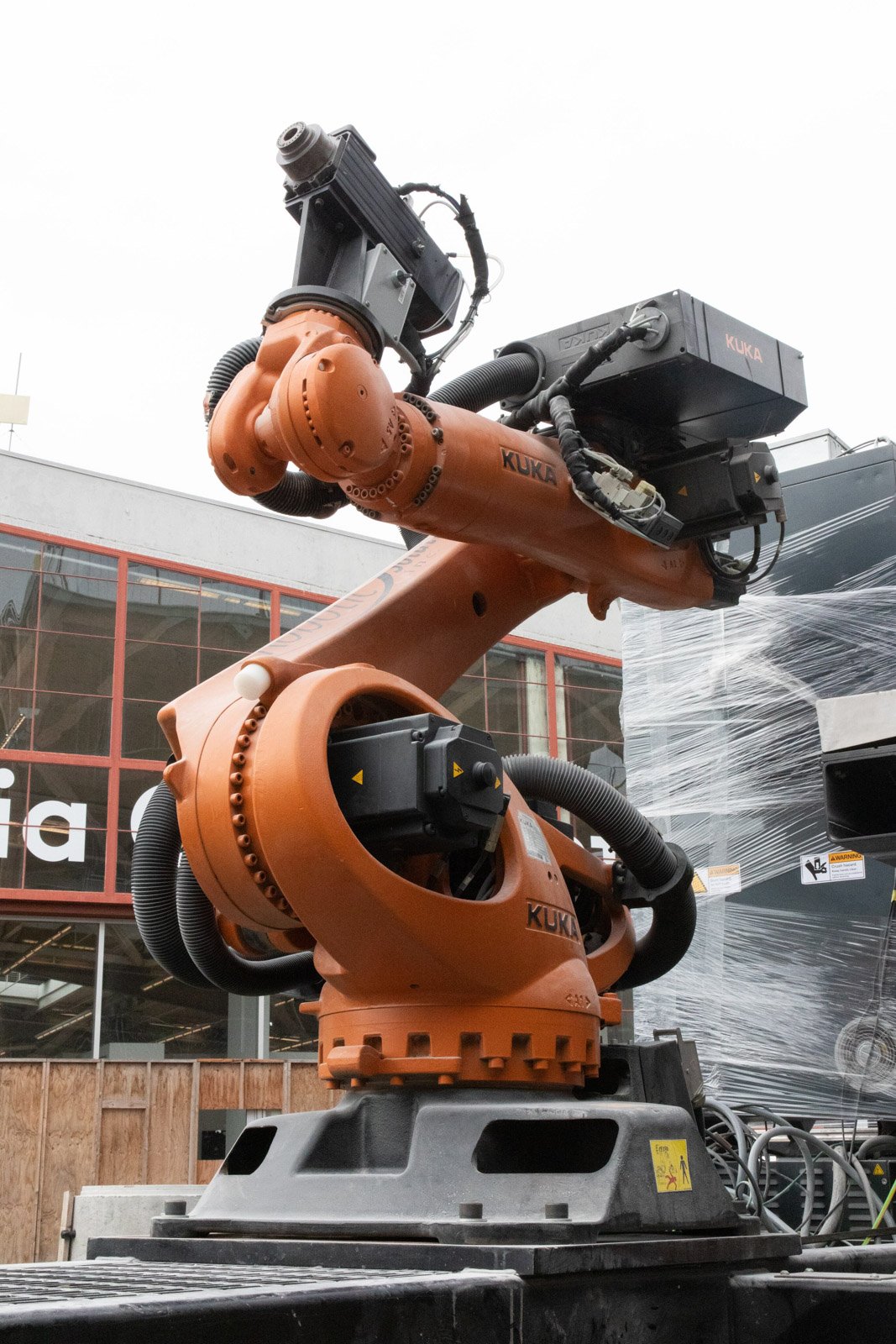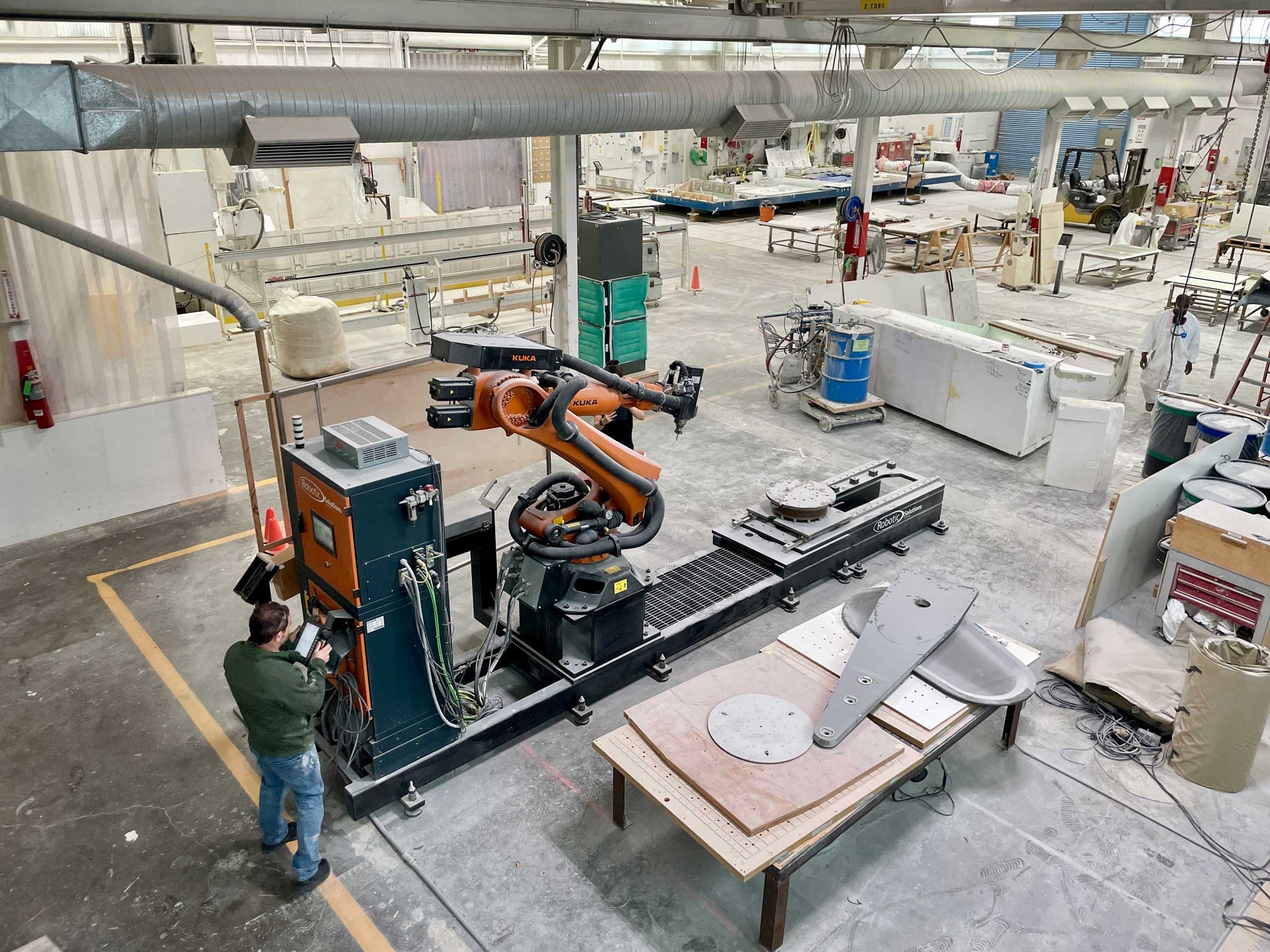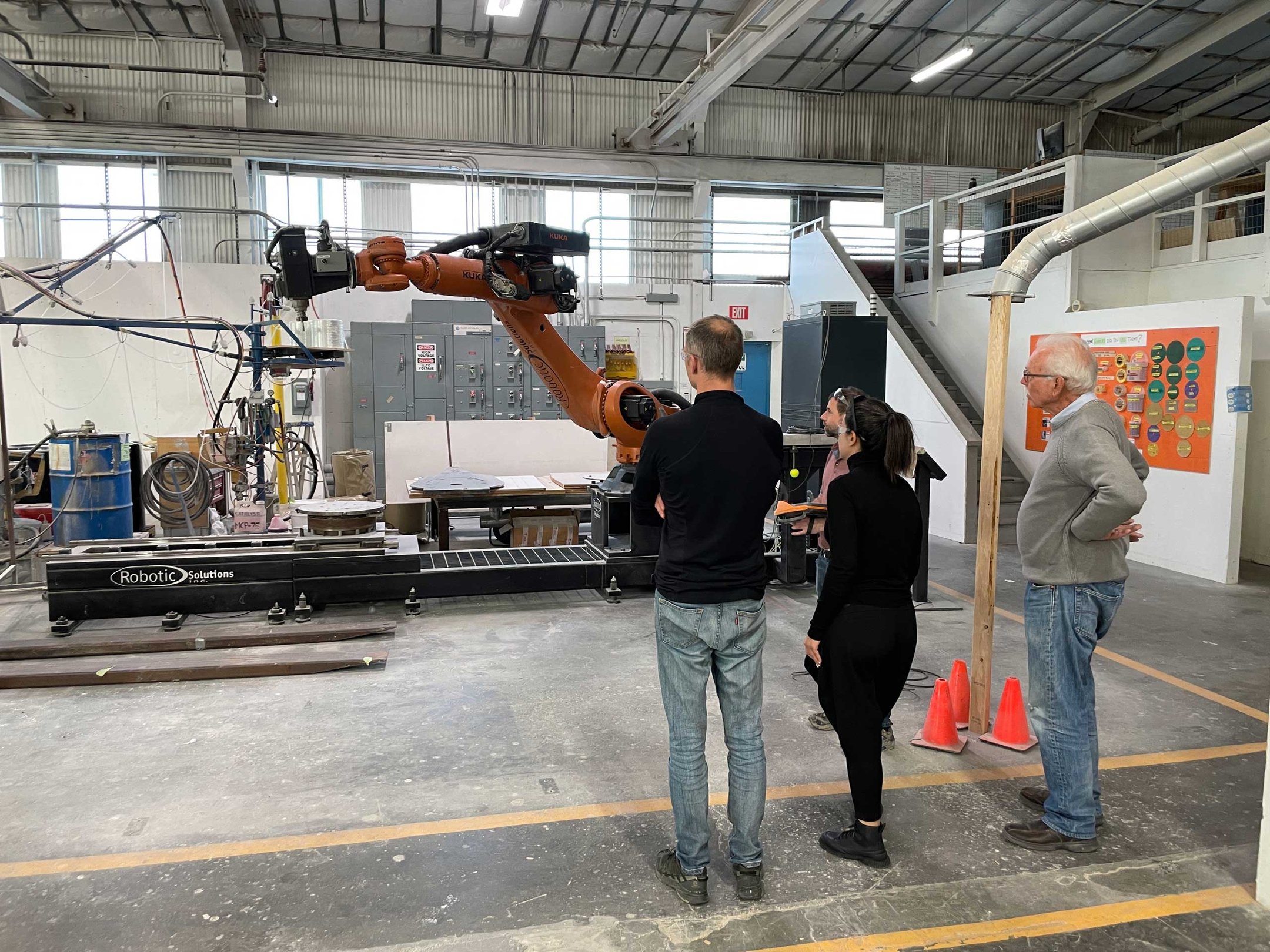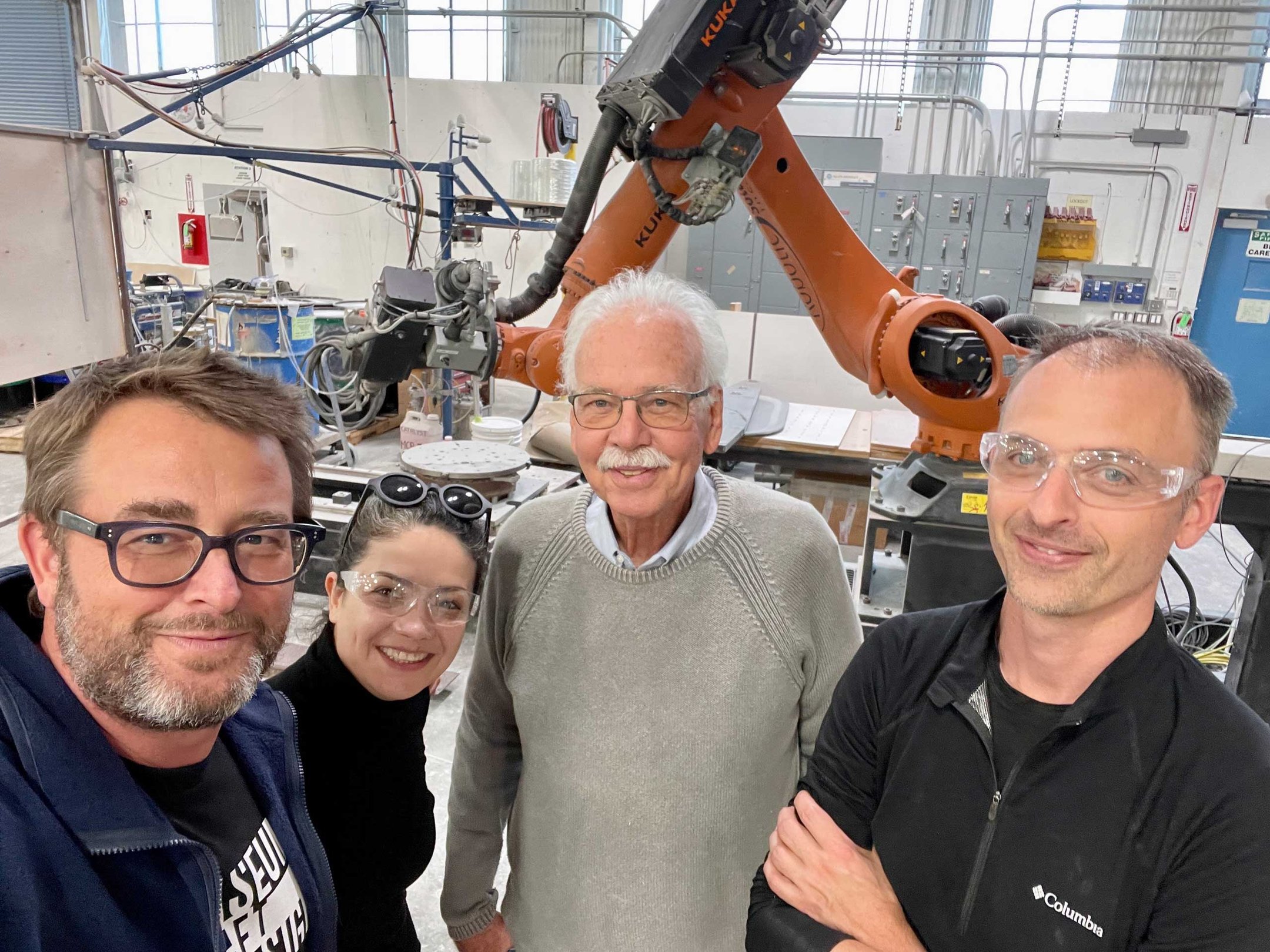A newly donated robot opens up possibilities for architecture and design
A large industrial KUKA robot joins CCA Architecture’s Digital Craft Lab, paving the way for faculty and students to extend their explorations of digital fabrication and material innovation.
How can a robot help us engage ideas and propose solutions to some of the most pressing architectural and ecological questions of our time? How can it offer opportunities for emerging architects and designers to be at the forefront of innovative, cross-disciplinary fabrication practices and material technologies?
The students, faculty, and collaborators of CCA Architecture will now have new and exciting opportunities to explore these questions. In February, an industrial KUKA robot was donated to the lab by Kreysler & Associates—one of the foremost digital fabrication firms in the U.S. —to support future generations of students and architects as they explore new methods of designing and building for human environments.

CCA's new KUKA robot is a generous donation of Bill Kreysler, president of Kreysler & Associates.
Dean of Architecture Keith Krumwiede says, “This incredibly generous gift from Bill Kreysler—a long standing supporter of CCA Architecture whose company, Kreysler & Associates, fabricated the Buoyant Ecologies Float Lab—comes at an opportune moment for the division and the college.”
“The Digital Craft Lab moves into a new space on the expanded San Francisco campus in the fall,” Krumwiede adds. “And this robot will not only support new teaching opportunities but will also enhance ongoing faculty and student research into new digital fabrication methods and material applications, including recent investigations into 3D printing with biomaterials, which just last year garnered the Outstanding Science Award at the Biodesign Challenge in New York.”
KUKA robots of this size are known for use in industrial environments such as car and electronics manufacturing where a robot can be programmed to mimic the precise human movements needed to assemble complex parts. A robot’s strength and precision, combined with its ability to work around the clock, have made it a valuable industrial tool.
But CCA Architecture has something new in mind for its KUKA robot, explains Negar Kalantar, associate professor of Interior Design, and Jason Kelly Johnson, professor of Architecture.
“Our interest in this particular robot is its capacity to do mass customization,” says Johnson. “We imagine using the robot for its capacity to embed parametric variation into art and architectural projects. It’s not about doing the same thing a thousand times like in a car factory, but doing thousands of unique tasks many times over.”

A view of Kreysler & Associates fabrication facility in American Canyon, near Napa, CA. Photo courtesy of Jason Kelly Johnson.
The robot also offers new opportunities to scale up projects and to create opportunities for diversity in the field.
The Architecture program’s Digital Craft Lab, one of CCA’s four teaching and research labs, will house the KUKA robot in its new home on the expanded CCA campus. The Lab, which specializes in advanced research in architectural design, construction, data visualization, and robotics currently has a small KUKA robot, but its size limits the scope of material experimentation.
Kalantar explains that’s how the donation of the industrial-size KUKA robot came about when she spoke with Bill Kreysler, president of Kreysler & Associates. Recalling her conversation, she says, “Our dream is to scale up these projects and how learning new technologies gives our students the skills to stand out, as well as bring about more opportunities for women and people with disabilities.”
Kreysler says, “We try to stay on the leading edge of manufacturing architectural parts and pieces. And working with CCA allows us to share information and better understand where architectural design is headed and help students sift through the realities of manufacturing—we learn from each other.”
Inspiring a hub for design and material innovation
For CCA’s architects and designers, a KUKA robot holds the potential to combine computer programming with custom arm attachments to explore and experiment with 3D printing using both traditional and non-traditional building and design materials, a technique that is relatively nascent in the United States.
“With this robot, you can achieve non-planar 3D printing,” says Kalantar. “Unlike traditional 3D printers that build objects layer by layer, robotic printing allows for non-planar printing. This method opens up new possibilities for creating unique architectural and design features”
Johnson echoes this vision and says, “I think we’re both interested in the capacity for this to be a big 3D printer. And I can see a whole range of material and formal experiments in our early use of the KUKA robot.”
“For example, last fall, in my advanced architecture studio, students were looking at parametric design and artificial intelligence in the design studio, and they were using it to try to fabricate,” he says, “So combining all of those with the KUKA robot; it’s going to open up all sorts of interesting and challenging terrain.”

KUKA robot demonstration at Kreysler & Associates in American Canyon, CA. Photo courtesy of Jason Kelly Johnson.
Students enrolled in CCA Architecture’s one-year MAAD (Master of Advanced Architecture Design) Digital Craft program will also benefit greatly. Johnson adds, “Our advanced MAAD students are some of the most talented graduate students anywhere in the U.S. They come to CCA from around the world to explore ideas surrounding digital craft. This new Kuka will allow them to gain cutting-edge knowledge and experience.”
The addition of the KUKA robot will also allow CCA Architecture students to learn the latest tools of their profession. “This is going to be a new field of practice for the next generation of designers and architects,” says Kalantar. “I think it’s going to open up the industry for them to be able to design for these new tools.”
The KUKA robot will be housed in the Digital Craft Lab which is moving to its new location on the expanded campus anchored by all-new, open-air Makers Yards that bring together studios and labs from diverse disciplines, including the Hybrid Lab, the Machine Shop, Ceramics Studios, the Metal Shop, and more.
For Johnson and Kalantar, the Digital Crafts Lab’s new location presents an opportunity to exhibit the products of their research and teaching, which could lead to fresh conversations and interdisciplinary explorations with designers and artists from across the college.
“The idea is that it becomes a place where people can see what’s happening,” says Johnson. “It’s very much going to be a part of the visual sequence of moving through the school and there’s going to be some really exciting opportunities for collaboration with other disciplines.”
Bolstering industry partnerships and the potential for new collaboration
The KUKA robot donation strengthens CCA Architecture’s long-standing industry partnerships and opens the doors for possible new academic and professional collaboration.
Kreysler & Associates has been a supporter of CCA’s Digital Craft Lab and the Architectural Ecologies Lab for several years. Its president, Bill Kreysler, is known as a global leader in digital fabrication of fiber-reinforced polymer composites which has been used in aerospace, museum design, and ecological restoration. Johnson says, “Bill’s career embodies innovation. He has been an incredible role model and collaborator over many years. The fact that a global leader and innovator in digital fabrication is based in the Bay Area has been a huge opportunity for CCA.”

Jason Kelly Johnson and Negar Kalantar (left) from CCA's Digital Craft Lab, with Bill Kreysler and Josh Zabel (right) from Kreysler & Associates. Photo courtesy of Jason Kelly Johnson.
Kreysler lauds CCA for its focus on craft. He says, “How to actually make things is one of the great shortcomings of most architectural schools. However, CCA is one of the very few where the faculty care about the how as well as the what and why. As construction evolves toward prefabrication, the burden of knowing falls more on the designer. The college is preparing their students for the future of construction which is coming fast. We like that.”
Additionally, CCA’s Architecture division is now in the fifth year of its formal Academic Alliance with Autodesk Technology Centers, the engineering and construction software company’s state-of-the-art research and innovation operation. This has allowed for students to participate in residencies at Autodesk’s San Francisco Technology Center at Pier 9 and advance work aligned with the Architecture Ecologies Lab and the Digital Craft Lab.
“As we explore the possibilities of innovating design and materials with new tools such as the KUKA robot, we hope it sparks interest from people and institutions who want to collaborate with us about what the future of making is going to be,” says Kalantar. “And we’re also thinking about those students who have a passion and interest for this work to join us as we dream about the future together.”